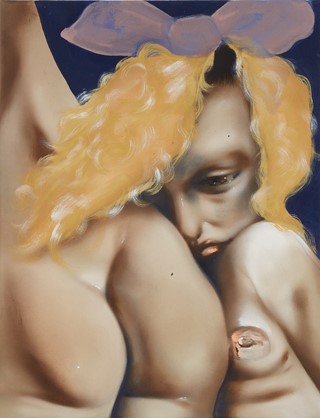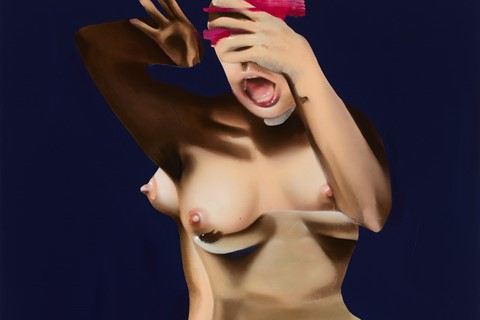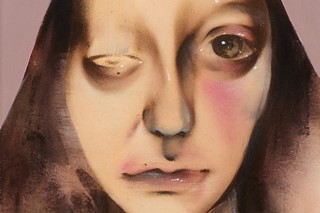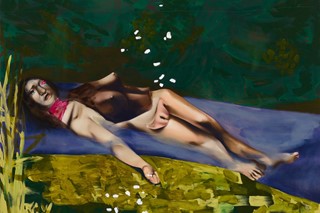As her new show opens in Antwerp, the London-based artist talks about her violent and seductive paintings, and why they are meant to make you feel “uncomfortable emotions”
Elsa Rouy’s raw paintings dredge up uneasy feelings. The artist depicts the body distorted, chopped up and remade, sometimes dripping in bright red or pink gore. Her human forms bare their teeth, twist their limbs at unnatural angles, and sometimes tangle themselves passionately around one another. There is a sheen to their skin which evokes both the facade of digitally created flesh and the body’s natural liquids. The artist has just opened a solo show, Ephialtes, at GNYP in Antwerp, and is also championed by Guts in London.
Her signature figures are originally built by collaging images found online and in magazines with parts of previous paintings. Rouy forms these collages in PowerPoint, removing and replacing different body parts and facial features, then painting the images onto canvas. She enjoys the speed of working with acrylic paint, as it helps to bring immediate emotion into the work. “There is a lot of melding of bodies,” she says when we speak ahead of the show opening. “It comes from this idea of cutting the body up, this nightmarish idea of a non-sense of self. But they are also made from a queer perspective, which is about having a non-distinct sense of the self. The paintings feel weird, there is an intrusion of the body, but they also feel powerful.”
While body horror has long had a place in her work, this new exhibition focuses on nightmares, which the artist has experienced to an intense degree since she was a child. Rather than depict specific scenes from her nightmares, she is interested in capturing the feelings they bring up. “There’s this play on life being nightmarish,” she tells me. “When you’re in a nightmare and everything is intense and quite confusing, and there’s this eeriness to it, this uncanniness … I wanted to capture that. When you’re feeling anxious or quite intense emotions in waking life, your brain also goes into that non-state where it doesn’t quite feel real.”
In both this exhibition and Rouy’s wider practice, there is a sense of finding understanding or connection within the horror, summoning a correspondence with the darker aspects of the self. She describes searching for satire and tenderness within her most recent body of work. Her nightmares, though often incredibly violent and scary, have become so known to her over the years that they have lost some of their initial impact and now arouse intrigue.
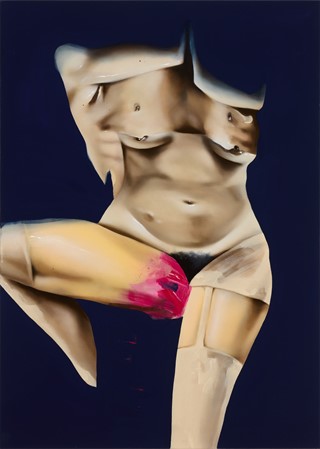
“Sometimes my nightmares are so messed up,” she laughs. “I wake up and tell my friends and they’re like ‘Why are you so casual about it?’ But this is my normal night! This show is an acceptance of the bad or the weird side of it. Or even an acceptance of the nightmarish parts of my own personality. It’s this look into the self, and maybe you don’t find the best things, but that’s OK. I think we have these horrifying ideas of ourselves and it’s about trying to feel comfortable with them rather than pushing them down.”
Subconscious thought is an ideal area for Rouy to explore some of these ideas, as this part of the mind typically exists outside notions of right or wrong. In the dream or nightmare world, we are perhaps freer to look at aspects of ourselves that we would find too shocking or disgusting to think about in the conscious mind. “It’s about looking at things from a different perspective instead of trying to run away from them,” she considers. “All my dreams exist in a grey area of morality. When you bring it into the waking life, that’s when people find it horrific.”
Viewers often have strong reactions to her paintings, which can be read at different moments as violent, seductive, repulsive, and vulnerable. They tap into feelings that viewers might have about their own bodies, and the darkness they imagine is contained within them. “For me, it’s about getting in touch with ideas of the self that a lot of people might hold,” says Rouy. “The bodies in the works are like a mirror. And the mirror does something to the viewer that’s maybe not so nice, but that’s not always wrong. It’s healthy to feel these uncomfortable emotions and question why you’re experiencing them.”
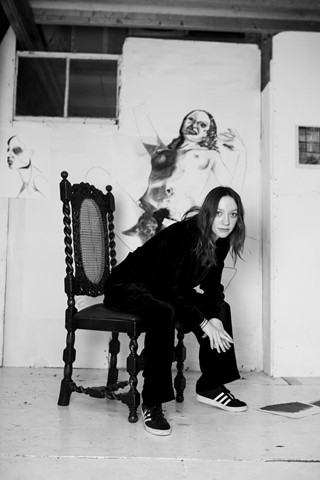
The body and mind are inherently connected in the artist’s work, which acknowledges how entangled these parts – which we often try hard to separate – really are. For Rouy, the paintings are cathartic, a space for her to visualise and process her own feelings and thoughts. “They’re like really strange diary entries,” she tells me. “They’re the only way I’ve found to express myself that feels really honest. When the paintings are in my studio, they’re mine, my personal things. Once they leave the studio, they don’t belong to me anymore, and whatever emotion I held towards them gets sent off as well. It’s like a release.”
Ephialtes by Elsa Rouy is on show at GNYP in Antwerp until 23 March 2024.
